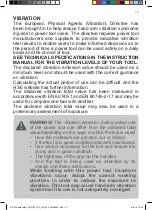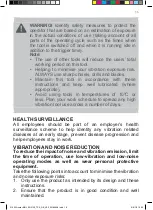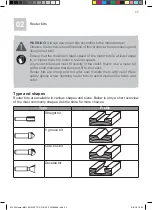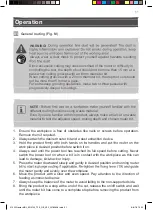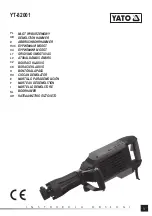
29
6. Lower the motor housing slowly by applying pressure on both main handles (1)
until the router bit touches the surface of the workpiece. Hold both main handles
(1) in position and lock the fixing lever (19) with the finger of the left hand.
7. Ensure that depth stop (7) stands on the step buffer (10) correctly and read the
indicated value on the scale (7a). Reduce the desired cutting depth to the read
value and lift the depth stop (7) accordingly.
8. Tighten the fixing screw for depth stop (8) to fix the depth stop (7) in position.
EXAMPLE!
The indicated value is 60 mm (6 on the scale (7a)), the
desired cutting depth 5 mm. The target setting value is 55 mm. Pull the
depth stop (7) upward until 55 mm is indicated.
NOTE:
It is recommended to perform a trial cut in a piece of test wood to
double check the cutting depth.
Fine adjustment (Fig. J, L)
Use the adjustment knob (3) for precise setting of cutting depth. The adjustment can
be done both in locking and releasing position of fixing lever (19).
Turning of adjustment knob (3) can perform fine adjustment of cutting depth according
following information:
1 mark on scale wheel (2) = 0.1 mm
1 turn of scale wheel (2) = 2.0 mm
1 mark on the scale (17) = 8 mm
Total adjustment range = 0-16 mm
1. Align the “0” mark on the scale wheel (2) with the fixed indicator on the motor
housing by turning the scale wheel (2) without touching the adjustment knob (3).
2. Rotate adjustment knob (3) clockwise to increase the cutting depth while the scale
wheel (2) turns with the adjustment knob (3) synchronously.
3. Rotate adjustment knob (3) anticlockwise to decrease the cutting depth while the
scale wheel (2) turns with the adjustment knob (3) synchronously.
NOTE:
After setting the cutting depth, the position of the reset-mark on
the depth stop should not be changed any more so that the currently
adjusted setting can always be read off the scale.
2100W router MNL_ER2100_TPS_GB_V02_20180608.indd 29
6/8/18 19:22

